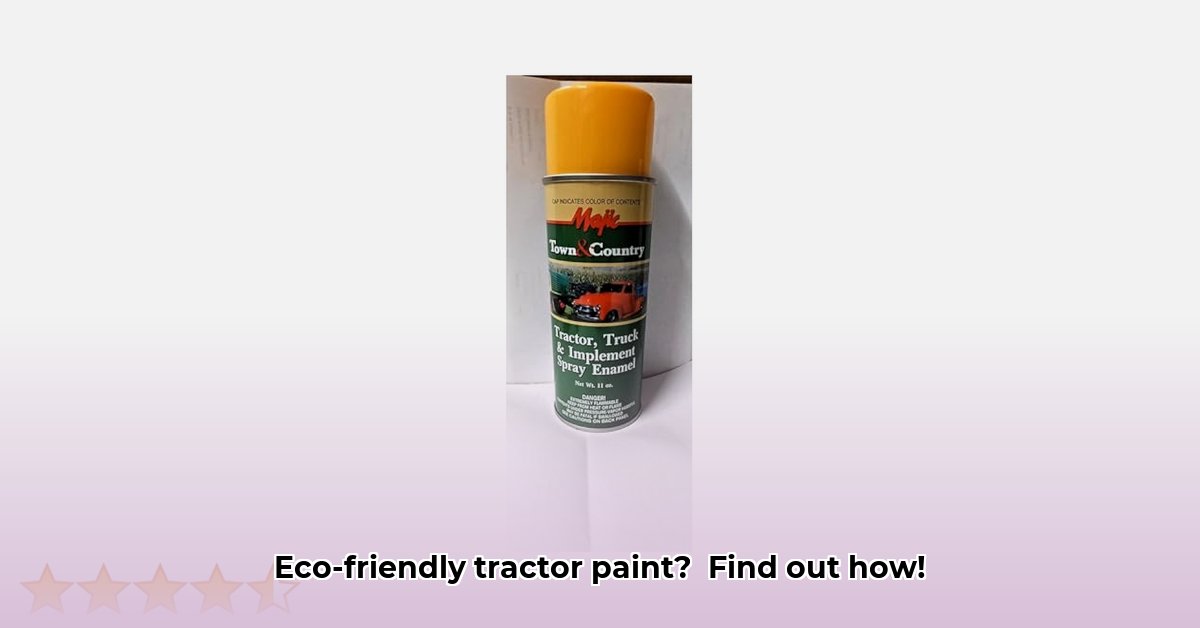
Tractor Spray Paint: Making Farm Maintenance Greener
Keeping farm equipment in top condition isn't just about aesthetics; it's crucial for efficiency, longevity, and minimizing environmental impact. But have you considered the surprising environmental consequences of your tractor's paint job? This article explores the hidden costs of traditional tractor paints and offers practical solutions for a greener approach to farm maintenance. For more on environmentally friendly pest control, check out this resource on effective tick sprays.
The Hidden Environmental Costs of Traditional Tractor Paint
Many conventional tractor paints contain volatile organic compounds (VOCs) – tiny pollutants released into the air during application and drying. These VOCs contribute significantly to smog and air pollution, harming both human health and the environment. Furthermore, the harsh chemicals used for paint cleanup add to waste problems. Disposing of leftover paint and containers presents another environmental challenge. These cumulative impacts are especially significant given the frequency of repainting farm equipment. Isn't it time we considered a more sustainable alternative?
Eco-Friendly Tractor Paint: A Smarter Choice
Fortunately, environmentally conscious alternatives are emerging. Low-VOC and zero-VOC paints, specifically formulated for tractors, are becoming increasingly available. Water-based paints offer a viable and often equally effective alternative to traditional options. When purchasing paint, look for labels clearly indicating "low-VOC," "eco-friendly," or "water-based." Even these small changes contribute to a larger, positive environmental impact.
Simple Steps to a Greener Paint Job
Here's a five-step plan to minimize the environmental footprint of your next paint job:
Thorough Research: Investigate the various low-VOC or water-based paints available. Compare costs, read reviews, and select the best option to meet your specific needs and budget.
Meticulous Preparation: Proper preparation significantly reduces paint waste. Thoroughly clean the tractor's surface, remove rust and old paint, and ensure proper priming. This upfront effort saves paint and money in the long run.
Efficient Spraying Techniques: Employ efficient spraying techniques for even coverage and minimal waste. Airless sprayers, often using less paint than conventional sprayers, are a worthwhile consideration.
Responsible Waste Disposal: Dispose of leftover paint and containers properly, adhering to all local regulations. Many communities offer hazardous waste drop-off sites for convenient and environmentally responsible disposal.
Invest in Durability: Consider investing in durable, longer-lasting paints. The higher initial cost is often offset by reduced re-painting frequency, minimizing both waste and long-term expenses.
The Big Picture: Benefits of Choosing Sustainable Tractor Paint
Switching to sustainable tractor paint offers numerous advantages:
- Improved Air Quality: Reduced VOC emissions translate to cleaner air, benefiting both human health and the environment.
- Enhanced Worker Safety: Minimized exposure to harsh chemicals creates a safer working environment for farmers and their employees.
- Reduced Landfill Waste: Utilizing eco-friendly paints and responsible disposal practices lessen the burden on landfills.
- Positive Brand Image: Demonstrating commitment to environmental sustainability enhances your farm's image and appeal to environmentally conscious customers.
How to Choose Eco-Friendly Tractor Paint for Sustainable Farming
Choosing the right tractor paint goes beyond aesthetics; it's a crucial component of sustainable farming practices. The paint's impact on your tractor’s lifespan directly affects both your finances and the environment.
Understanding the Environmental Impact of Tractor Paint
Traditional paints often contain high VOC levels, contributing to air and water pollution. These chemicals negatively affect air quality and pose potential health risks. The disposal of used paint also presents environmental challenges. Therefore, choosing eco-friendly alternatives directly reduces your farm's carbon footprint.
What Makes a Paint Eco-Friendly?
Look for paints explicitly labeled as low-VOC or zero-VOC. These often utilize water-based formulas, minimizing harmful emissions. Investigate the paint's recyclability and whether it incorporates recycled materials. A truly sustainable paint minimizes waste throughout its entire lifecycle.
Factors to Consider When Choosing Eco-Friendly Tractor Paint
| Factor | Description | Considerations |
|---|---|---|
| Durability | Paint lifespan before requiring reapplication. | High-traffic areas necessitate more durable options. High-quality, eco-friendly options are available. |
| Cost | Initial price plus any additional costs (e.g., specialized applicators). | Balance initial cost with the potential for longer lifespan, reducing the need for frequent repainting and minimizing waste. |
| Application | Ease of application (brush, roller, spray). | Choose a method and paint type compatible with your skills and resources. |
| VOC Content | Amount of volatile organic compounds released. | Prioritize paints with the lowest possible VOC content. Always check product labels for specific details. |
| Color & Finish | Aesthetic properties (color, sheen, texture). | Color choice affects heat absorption (darker colors absorb more). Consider the overall aesthetic impact on your farm. |
Choosing the Right Paint: A Step-by-Step Guide
- Assess Your Needs: Consider the tractor's condition, usage, and environmental exposure.
- Research Eco-Friendly Options: Explore paint types, focusing on VOC content, durability, and cost.
- Read Product Labels Carefully: Look for certifications and detailed VOC content information.
- Compare Prices and Features: Consider the total cost, including paint, preparation supplies, and application.
- Choose Your Application Method: Select the method that best suits your skills and equipment (brush, roller, or spray gun).
- Prepare the Surface Thoroughly: Proper preparation ensures optimal adhesion and paint longevity.
Remember, choosing eco-friendly tractor paint is not about compromising quality; it's about sustainable practices. Making informed decisions reduces your environmental impact while ensuring your equipment's protection and functionality. It's a clear win-win for both your operation and the planet. https://www.epa.gov/paint